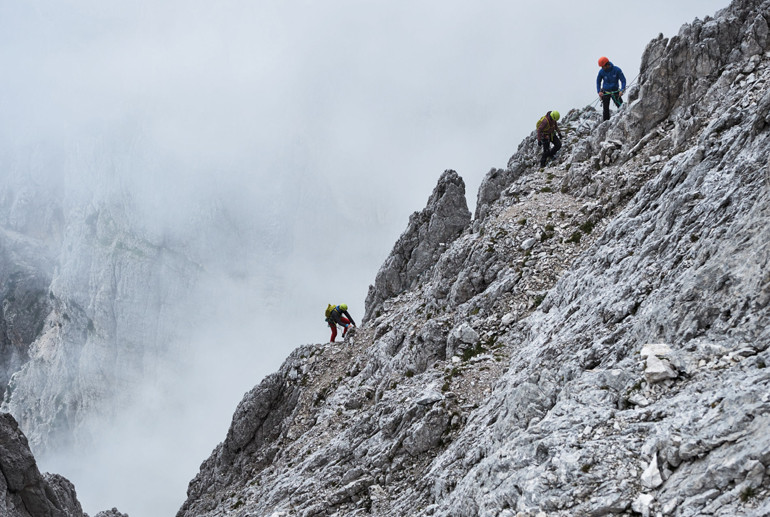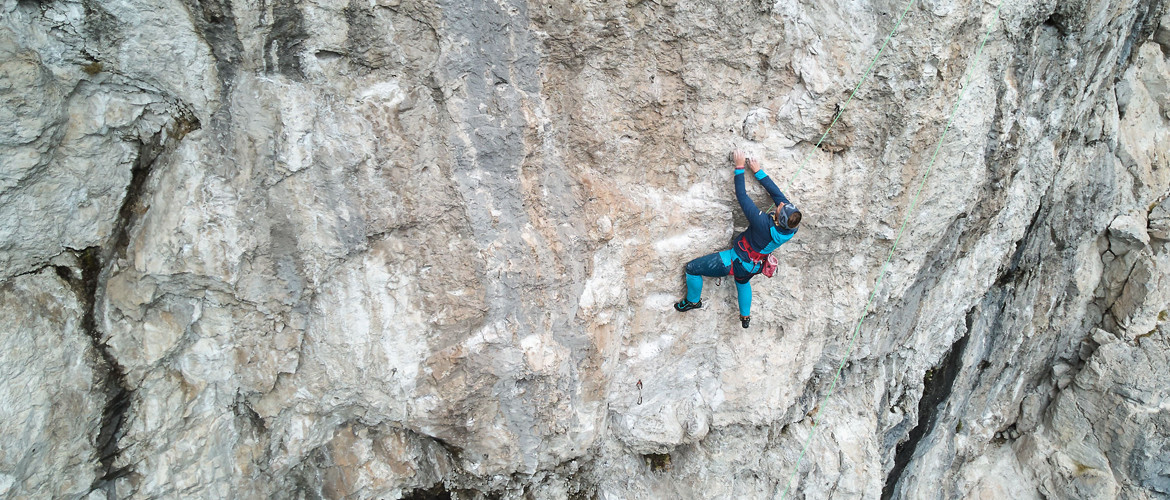LIFE ON THE VERTICAL
The clouds briefly disperse. The towering peaks which stand watch over the village of San Martino di Castrozza, in the heart of the Dolomites, come into view. This, weather permitting, is our next destination. Slowly but surely, the contestants selected to participate in Salewa’s “Get Vertical” competition begin arriving at the hotel in the postcard-perfect Italian town. Like every year, the organizers were looking for outdoor enthusiasts eager to take part in a unique experience, in spectacular surroundings. Aspiring contestants were asked to share their experiences and worries, in addition to sending photos for a chance to take part in the "Get Vertical" challenge.The lucky winners were composed of a Greek, two Belgians, three Italians, two Poles, a Czech, a Slovenian, an Austrian, and a Spaniard. This eclectic mix of strangers would make up the 2018 Get Veritcal Salewa team.
As it pours down rain, the San Martino guides arrive at the hotel, which means our first climbing session together can begin. Here, we're split into two-person climbing groups, who will each be assigned a guide. Things couldn’t go better for me. I’m assigned to Loes, a younger Belgian climber, as strong as an ox, who informs me that she spends all day at the climbing wall, since her country doesn’t have many mountains or faces for climbing. It sounds like we’ll be moving pretty quickly. Our guide, Cristiano appears strong, as you would expect of someone in his line of work. He’s middle-aged and has over 200 climbs on the faces of San Martino under his belt. Next up is getting us equipped. We hand out the Salewa kit as if we were in the sales, searching for things that would serve us for the lengthy, formidable faces of the Dolomite mountains. We’ve only caught a fleeting glimpse of them from the valley as yet, but their verticality and sharp silhouettes are nothing but intimidating.
ATTACK!
Mountaineering demands an early start with a decent breakfast, since you never know what lies ahead. That’s exactly what we do in order to reach the cable car, which will take us up to within easy reach of the Rosetta summit. As we gain altitude, we move through clouds, clear skies, rain and fog. The weather looks somewhat unpredictable when we reach the top, but we are all determined to try to climb, which is what we’ve come to do. First of all, we leave some of the equipment in the Rosetta refuge, which is where we will be sleeping tonight. After a short walk, we are all ready to get started. By now, we’ve already had the chance to get to know each other, all of us learning bits and pieces about the different cultures and perspectives around us.
Everyone has a story about where they climb back home, what "schools" are like in their country and the other sports they partake in. The Belgians, Loes and Sebastian, informed us that they have to go to France in order to find a decent climb! Before we even began our Get Vertical adventure, Loes and Sebastian were so excited to get climbing that they arrived early to give the Dolomite limestone a try. Dimitri, the Greek, comes from a different environment where the heat often dictates when and where he is able to climb. The Polish girls have to wait out the harsh winter, in order to be able to access their climbing routes. While the snow and cold weather stick around for the season, the girls train day in and day out at the indoor “wall” to ready themsevles for the outdoor climbing season.
Conversations about climbing continue to flow in various languages until Carlos arrives. (After a travel odyssey) He’s another old-school climber who has been taking on the mountains in northern Spain for 20 years. With so much climbing knowledge in the room, we begin to discuss the Picos de Europa, Naranjo, old-school climbing and the tough people from years ago who designed the trails. With the newly predicted rain at noon, our conversations fall short of being finished and we head to the Dolomites. If we want to give the Dolomite rock a try, we better move quickly.
Cristiano comes running out of the refuge in search of our trail. He knows this terrain like the back of his hand, so we follow him through the fog along ridges and rocky paths, as we circle the Rosetta peak to reach its southern face. There we find the Levitti trail; which is around 250m high, split into five sections, and a difficulty rating of V+. Another climbing group accompanies us to the base of the wall. It seems there’ll be six of us climbing around the same time, while the rest of the group is split up to give other trails a try. When we reach the wall, we check that it’s dry and that it’s safe to climb. For a moment, we thought it would be more like a waterfall than anything else, but we’ve been lucky. Cristiano puts on his climbing shoes and sets off like a rocket upwards through broken terrain. Traditional wall climbing requires some coordination, even more so if you’re in a group of three. You have to know the safety manoeuvres, the pace at which to climb, remove the "gadgets" left behind by your teammate, and not lose time at meeting points - where there's usually a jumble of strings and material.
Despite the fact that I haven’t climbed for a year, and that I’m unfamiliar with the terrain, things go smoothly from the beginning. Loes latches onto Cristiano for the first section. As soon as he reaches the top, we head up. The weather seems more akin to winter in Spain than anything else. We climb up fast, the terrain isn’t complicated, but the rock, as expected in these mountain ranges, has been besieged by the harsh winter, and is broken in some sections. It’s important to make sure that what we grab hold of is firm and won’t break, and pay attention to where we step. You can easily hurl stones at those below you if you're not aware of where you're stepping. To my surprise, from a few meters above me, a rock comes flying down and hits me in the shin. This incident made me even more conscious of where I was stepping for the rest of the climb.
The last two sections were the most exciting because of their steepness and the fact that the clouds begin to envelop everything, making us want to reach the top as soon as possible. We reach the base of the last section. To our surprise, the ground was dry, the morning's rain hadn't reached this altitude. In the middle of the track there is a ledge that requires us to accurately position our feet, taking advantage of the support provided by the dihedral; the area between two faces that are more or less at 90 degrees. When the clouds open behind us, the sensation is difficult to describe. The mountain faces in this area of the Dolomites reach for the sky with a wild verticality. They huddle side by side, creating a feeling of immensity which makes you feel small. The stretch to the top gives us a chance to catch a glimpse of the upper part of Rosetta. Just as we are collecting our materials, the sky breaks and a powerful summer storm begins. We run to the shelter. As the rest of the climbing group finishes on the wall, the shelter becomes more and more crowded. We’re all wet, but with smiles on our faces. We have managed to scale one of the most emblematic places in Europe.
CLIMBING GROUP: TEAM WORK
If there is something that comes to the fore when you find yourself on rock face or a tall mountain, it’s your relationship with your partner. Generally speaking, climbing groups are comprised of two climbers that are reletively similar in strength and skill.
During dinner, we listen to Jacek Matuszek. He is a Polish climber from the region where many of the toughest mountaineers the Himalayas have ever seen hail from. He is the ultimate Salewa icon and takes advantage of the opportunity to tell us about his adventures in the Dolomites. Jacek spent five years climbing the most difficult "big wall" trails, so you can imagine what his stories were like.
In most of his stories, his relationship with his climbing partners takes center stage. The feeling of connection spreads amongst all the Get Vertical members, who are now laughing as they exchange their adventures on mountains, ice, rocks, and in life. The second day on the walls of San Martino starts badly, and our hopes of climbing one of the nearby high peaks are overshadowed by the storm that forms over the refuge. The team of guides decides to look for a nearby collapsed wall, which remains dry despite the rain, to do some sport climbing. We put on our climbing shoes and harnesses again and put our skills to the test on trails ranging from 6b to 6c +. Meanwhile, Jacek gives a demanding 8° trail a try, which he manages on the second attempt. It's nice to see the professionals climb.
The second part of the day is spent travelling the 9 kilometres that separate us from our next destination, the Pradi – Dali refuge, located at 2,800m. After two hours of climbing and descending along zigzag trails, we arrive at a magnetic site - a place you can’t stop taking photos of it. The refuge, which is a big hit with the guides since they party there every night, is at the base of a mountain face which is almost one kilometre high. It looks like a toy next to this huge mountain. Carlos and I spent the whole afternoon thinking about the trails we could tackle if we had good weather, while Cristiano explains to us where each route goes. This face is brutal, there is a direct climbing trail, named "Buhl", after the famous mountaineer. It doesn’t seems like we’re going to give this mammoth climb a try this time, but the landscape surrounding the refuge is unique and it is worth having travelled here just to see it.
Salewa's Get Vertical experience ends the next morning with another great hike down to the valley in some light rain. After three days in the company of the winners of the contest and the brand’s team, it’s clear that the environment and the relationships established are unique. We arrived like strangers and we have returned as climbing companions and friends.



 Free shipping on orders over $200 - No minimum for registered users
Free shipping on orders over $200 - No minimum for registered users